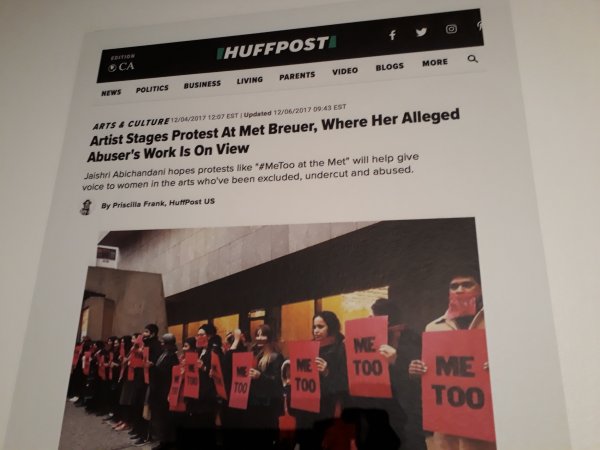
|   |

|   |
 e-mail: arshiyasethi@gmail.com "#TimesUp", and it is your time now: Why the dance world needs to think about "#MeToo" September 19, 2018 I had different plans for this column till I visited the Royal Ontario Museum and realised that the coming month of October marks a year since the "Weinstein moment" and the start of the "Times up" and "Me too" movements. I felt I owed it to dance, in fact to all arts, to talk about this unhappy reality of our world. For too long have issues like this been pushed under the carpet, weighed down with discomfort in dialoguing, wrongful restrictions of 'respect', and all of this has always worked against us women. In Canada presently for lectures, and a chance to spend some time with my son, I went one morning to one of Canada's largest museums, the Royal Ontario Museum, where an exhibition of photographs by one of India's most iconic, visionary and celebrated pioneers in colour photography, Raghubir Singh (1942-1999) were on display, in a special exhibit, a career spanning survey of his work, titled "Modernism on the Ganges". The exhibition was organized by The Metropolitan Museum of Art with the cooperation of Succession Raghubir Singh, and made possible by Nita and Mukesh Ambani and the Reliance Foundation. Singh who was known for his "democratic eye", and his ability to capture moments of eternal truths despite the constant movement of India's hordes, in the continuous play of multiple colours, seems to have failed in these qualities closer to home. A truth brought to the fore, dramatically, twenty years after his death, at the inauguration of the premier showing of this exhibition earlier this year, at the USA's largest art museum, the Metropolitan Museum of the Arts in New York, colloquially called "the Met".  On 3rd December, in New York, a group of women and men protested, standing in a line, against the Met's grey exterior, each holding up a red sign reading "Me Too" in black letters, with red sashes gagging their mouths. One sign was different. It said "I survived... Raghubir Singh # Me Too!" That one was held by Singh's one time assistant Jaishri Abhichandani (48), born in Mumbai and raised in Queens. Abhichandani, now based in Brooklyn, alleges that Singh coerced her into sex during what she thought was a work trip to India when she was 25 and he was 52. He refused to hear her verbal refusal, and since it was not consent, "It's rape," she says. The crime was compounded by entrapping and isolating her in an unfamiliar space, and following it up with over a year of verbal abuse and intimidation on return to New York. The silent protest was allowed inside the gallery too, in a moment of recognising the new challenges that the arts would need to confront henceforth. When the exhibition moved to ROM in Toronto, the museum had a few months lead, to address the gendered crisis of our times - the use of power, usually by men, to sexually exploit women. In this case the situation was made more complicated by the fact that the alleged abuser was not just iconic, but also dead. Yet silence towards such moral turpitude would be a terrible disfavour to their survivors (I really don't want to use the "helpless" and agency deficit word of victim). To the audiences, investors and interpreters of their art, silence would represent compromised curatorial veracity. Now that the truth of many greats like Picasso and Gauguin has surfaced, can they ever remain in that same canonised position for us? Should one just block them out, by cancelling their work as the National Portrait Gallery in Washington, D.C. did when in January, it decided to kill a career survey of the painter Chuck Close, scheduled for May this year, when reports emerged he had harassed some of his models. Or can one separate the art from the artist? Increasingly are arts institutions likely to be confronted with such choices, and so what the ROM did is an example of what is possible. In a ticket free access gallery, enroute to the paid parts of the museum, in a prominent place near the entrance, it mounted another exhibition "#MeToo in the Arts", tracing the evolution of the 'me too' phrase and the spirit of the movement and linking it specifically to the ongoing exhibition of Singh's pictures. Then in a sensitively edited film carrying the voices of a spectrum of stakeholders from arts and their institutional domains, including the voice of South Asia curator Deepali Dewan, and activists working on women's issues, the issue is nuanced. We know that art work has been created often to feed the male gaze stressing beauty and sexuality. Iconic stature or various subtle forms of patriarchy has permitted glorification despite disturbing behaviour? While living artistes can make amends, how do we handle a dead artiste? Do we need to obviate their role in the art experience and evoke erasures? Admittedly these are difficult conversations, but there is much that we know, more than what we are willing to talk about, and much more that we need to know. Recognising the complexity of the issues, ROM curator Deepali Dewan refers to this #MeToo display as a "milestone" in the way the museum has handled this difficult content, suggesting this could be the new norm for problematic projects. I raise this issue in a column primarily on dance because the world of dance is a difficult world, operating in a liminal zone between feudal ways and modernity. The transactional nature of patronage today, the loss of the sheen around the Guru Shishya parampara and the absence of marked pathways of progress, dancers often find themselves dependant on the whims of promoters, and bureaucrats. Additionally the continuous socialising of women towards the ideal of docility, the conspiracy of silences, and the imbrications of the subtle stigma against those who dance as "body" people, makes dancers more vulnerable. It is time that dance schools started living in our times and focusing on more than just the seductive beauty of the arts, to prepare dancers to recognise such behaviour, know their rights and learn how to deal with such aberrations. It is time we speak out, stay together and look out for each other. "#TimesUp" for sure, for any other way of handling situations of overt or covert sexual inappropriateness, misconduct, molestation and exploitation.  Dr. Arshiya Sethi, trained in Kathak, has served as dance critic, commentator, institution builder for the arts, having created both tangible and intangible institutions and equities. She has been a Fulbright Arts Fellow (2003-2004) and a post doctoral Fulbright (2016-2017). Her doctoral work has been on the link between politics and dance in the case of Sattriya. She is presently working on the intersection of dance and activism / social justice as well as Indian dance in the diaspora. Post your comments Please provide your name and email id when you use the Anonymous profile in the blog to post a comment. All appropriate comments posted with name & email id in the blog will also be featured in the site. |